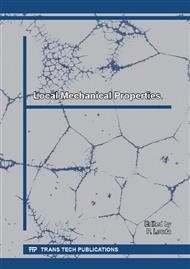p.107
p.111
p.115
p.121
p.126
p.130
p.134
p.138
p.142
Effect of Neighboring Phase Properties on Measured Indentation Data
Abstract:
The paper focuses on the variation of mechanical properties near the interface of two materials. The aim is to determine the properties of the individual phases and the size of the region influenced by the adjacent material. Nanoindentation measurements were performed in the vicinity of a sharp interface between tungsten and steel, which was a plane located parallel to the loading force direction. The probability of indentation in the affected area as a function of depth of penetration and distance from the interface was fitted by a proper statistical distribution function. The intrinsic properties of the individual phases can subsequently be extracted from the experimental indentation data.
Info:
Periodical:
Pages:
126-129
Citation:
Online since:
July 2016
Authors:
Price:
Сopyright:
© 2016 Trans Tech Publications Ltd. All Rights Reserved
Share:
Citation:


